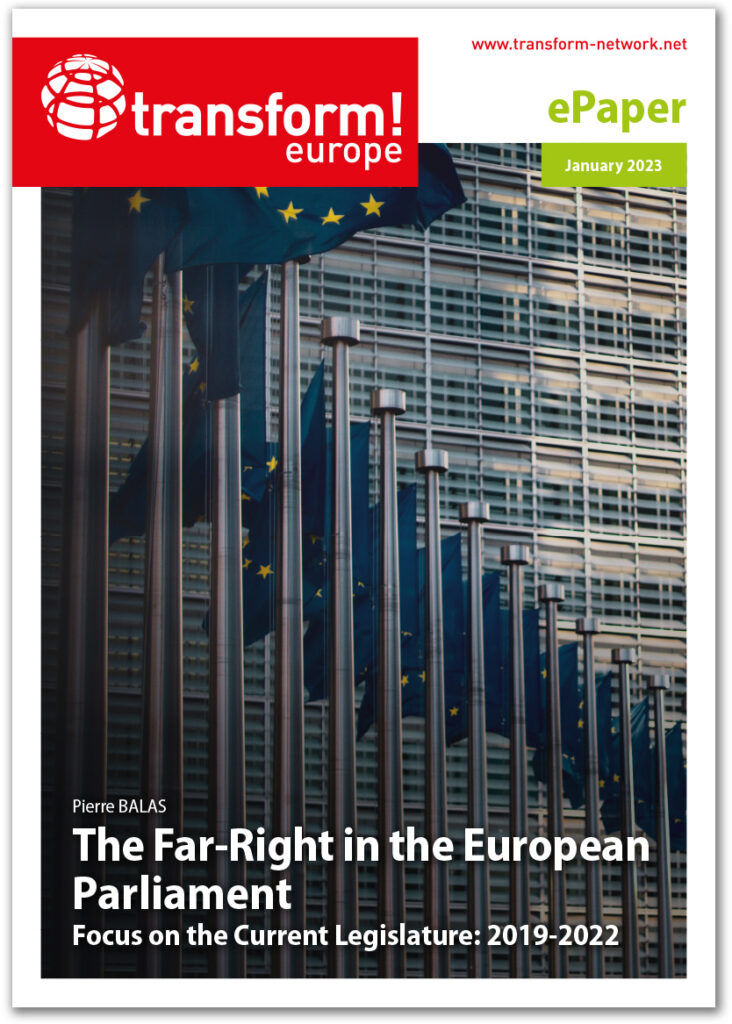The aim of this study is to examine the far-right in the EP from 2019 until today (September 2022) from different angles and to provide answers to the questions regarding what happened after the 2019 elections, how the European far-right is organised in the EP and what the connecting factors and dividing lines between the far-right parties are.
Please find the ePaper on the left/below (mobile version) in ‘Documents’ (English, PDF).
The influence of the far-right has globally been rising in every aspect of society (street mobilisations, political discourses, public debate, etc.). The European Parliament is not immune from this shift. Media and political commentators even feared a far-right tidal wave during the 2019 European elections campaign (9th legislature). Even if it did not occur, far-right political forces are doing well in the European Union and in extenso, in the EP.
In the context of this paper, the term “far-right” refers to the EP political groups sitting to the right of the European People’s Party (EPP): Identity and Democracy (ID), European Conservatives and Reformists (ECR) and some of the Non-Attached MEPs (NA).
The purpose of the paper is to investigate the far-right in the EP from 2019 until today (September 2022) on different aspects: What happened in the 2019 elections? How is the European far-right organised in the EP? What are the rallying points and the divides among far-right parties? How do they use the EU? Do they have any counterproposal to the European project?
This paper considers these questions through four main parts and two focusses:
- Section I. analyses what is new in the 2019 legislature compared to the previous one (2014-2019): structure of the groups, electoral results, and impact of the Brexit.
- Section II. brings to light the far-right parties’ views on the EU.
- The first focus details the reasons why it is challenging for the far-right to be united in the EP.
- Section III. lists the material and immaterial benefits for far-right parties to invest in the EU and then concentrates on the positions held by far-right parties to understand their influence in the EP.
- Section IV. draws attention to three recent votes to get a glimpse of the political rationales used by the far-right in the EP.
- The second focus is a concluding conversation with Nathalie BRACK, political science professor at the ULB.
Table of Contents
Summary
Introduction
Abbreviations
I. Far-Right in the European Parliament: How Has It Evolved Since 2019?
1. The Far-Right After the 2019 European Elections
2. Changes in Group Composition Since 2019
II. What Are the Far-Right’s Criticisms of the European Union and its Counter-Projects?
1. The Far-Right’s Criticisms of the EU
2. ID’s and ECR’s Counter-Projects for the European Union
3. Other Topics to Consider
#1 Focus: The Absence of a Single Far-Right Group in the EP. Why?
1. The Will of Union: From an Initial Ambition to More Modest Achievements
2. Reality Check: Points of Contention
III. How Far-Right Political Parties Use the EU?
1. Material and Immaterial Benefits of Investing the European Arena
2. ID and ECR in EP Top Jobs
3. ID, a Victim of the “Cordon Sanitaire” vs. ECR, a Respectable Group
IV. A Look on Three Votes
1. EU-Vietnam Trade and Investment Protection Agreements (2020)
2. Conditionality for the Protection of the Union Budget (2020)
3. New Avenues for Legal Labour Migration (2021)
#2 Focus: Interview with Nathalie BRACK
Appendix
Methodological Approach and Remarks on Data
Bibliography
